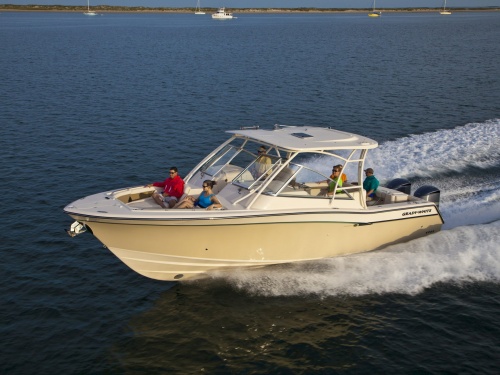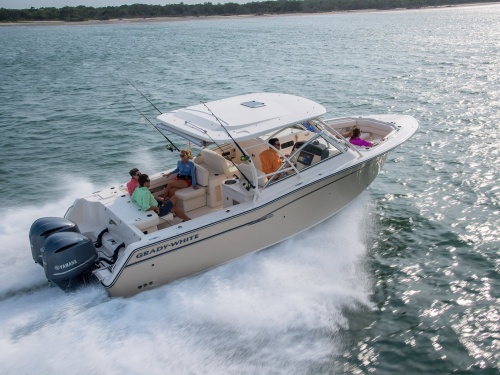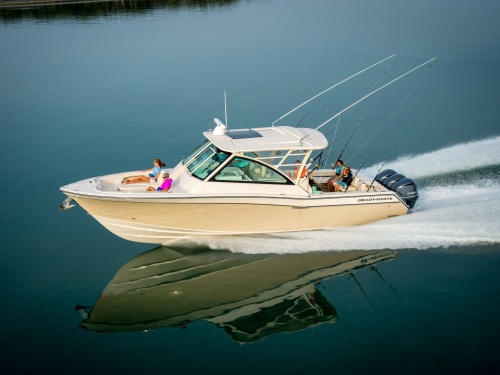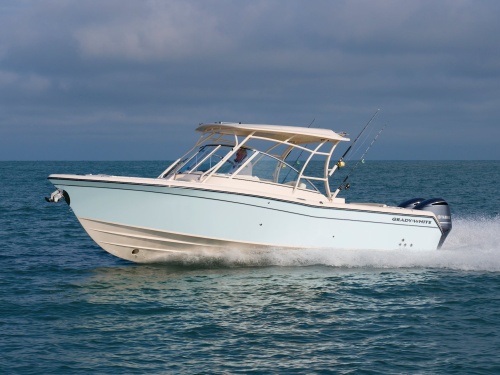Access More Boat Tests
Already have an account? Login
Grady-White Freedom 325 (2018-)
2 x Yamaha 300 Four Stroke
Brief Summary
Grady-White has long been a company that improves on itself, and the Freedom 325 is another example of it doing just that. The company has had a great success story with both the Freedom 307 at 30'6" (9.30 m) and the Freedom 335 at 33'6" (10.21 m), but clearly needed to fill the gap between the two and make the product accessible to more people, without having to make that big of a jump. The Freedom 325 fills that gap. At 31’2” (9.50 m) when measured the same way, down the centerline to the transom, she falls nicely into the niche. This new model, however, also adds integrated swim platforms that the others do not, so her actual LOA is 33'1" (10.08 m). It fills a perfect spot that provides the creature comforts and space of the Freedom lineup, while at the same time, adding a few more amenities from the smaller version.
Key Features
- Self-bailing cockpit with cockpit drains
- Automatic bilge pumps (total 3,000 GPH) (11,356 LPH)
- Forward bolsters
- Stainless steel through-hull fittings
- 288-gallon (1,090 L) tank
- Hydraulic trim tabs with indicator and retractor
- Starboard console with cushioned berth, bulk storage, and indirect lighting
- Anchor windlass with remote switches at helm and windlass
Test Results
| RPM | MPH | Knots | GPH | MPG | NMPG | STAT. MILE | NM | dBa |
|---|---|---|---|---|---|---|---|---|
| 600 | 21.4 | 18.6 | 1.3 | 17.1 | 14.9 | 4427 | 3849.7 | 68 |
| 1000 | 6.2 | 5.4 | 2.6 | 2.4 | 2.1 | 618 | 537.5 | 66 |
| 1500 | 7.9 | 6.8 | 4.3 | 1.8 | 1.6 | 479 | 416.3 | 71 |
| 2000 | 9 | 7.8 | 6.8 | 1.3 | 1.2 | 344 | 298.9 | 75 |
| 2500 | 11.1 | 9.7 | 10.1 | 1.1 | 1 | 286 | 248.9 | 79 |
| 3000 | 18.2 | 15.8 | 13.2 | 1.4 | 1.2 | 359 | 311.9 | 84 |
| 3500 | 27.1 | 23.5 | 17.2 | 1.6 | 1.4 | 409 | 355.5 | 86 |
| 4000 | 31.9 | 27.7 | 22.4 | 1.4 | 1.2 | 370 | 321.7 | 89 |
| 4500 | 37 | 32.2 | 28.4 | 1.3 | 1.1 | 338 | 293.6 | 90 |
| 5000 | 41.6 | 36.2 | 36.1 | 1.2 | 1 | 299 | 259.7 | 92 |
| 5500 | 45 | 39.1 | 43.4 | 1 | 0.9 | 269 | 234 | 93 |
| 6000 | 48.1 | 41.8 | 53.4 | 0.9 | 0.8 | 233 | 203 | 95 |
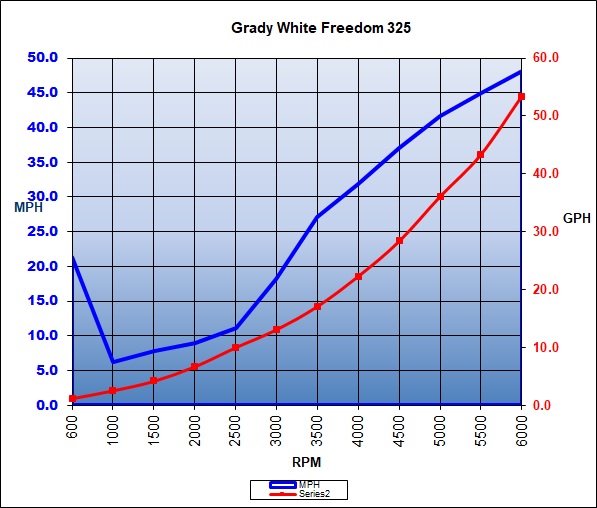
Specifications
| Length Overall | 33' 1'' / 10.1 m |
|---|---|
| Beam |
10' 9" 3.28 m |
| Dry Weight |
9,300 lbs. 4,218 kg |
| Tested Weight |
12,598 lbs. 5,714 kg |
| Draft | N/A |
| Draft Up |
24" 61 cm |
| Deadrise/Transom | 20 deg. |
| Max Headroom | N/A |
| Bridge Clearance |
8' 10'' 2.69 m |
| Weight Capacity | N/A |
| Person Capacity | N/A |
| Fuel Capacity |
288 gal. 1,090 L |
| Water Capacity |
30-gal. 114 L |
| Total Weight |
12,598 lbs. 5,714 kg |
Acceleration Times & Conditions
| Time to Plane | 3.5 sec. |
|---|---|
| 0 to 30 | 8.2 sec. |
| Ratio | N/A |
| Props | 17TL 15 1/2 Saltwater |
| Load | 2 persons, 1/2 load fuel, no water, 50 lbs. of gear |
| Climate | 61 deg., 5 humid.; wind: 0-0 mph; seas: calm |
Engine Options
| Tested Engine |
2 x Yamaha 300 Four Stroke |
|---|---|
| Std. Power |
Not Available |
| Opt. Power |
2 x 300-hp Yamaha Four-Stroke 2 x 350-hp Yamaha Four-Stroke |
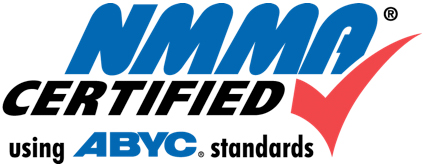 Learn More
Learn More
Watch Our Video
Contents of Report
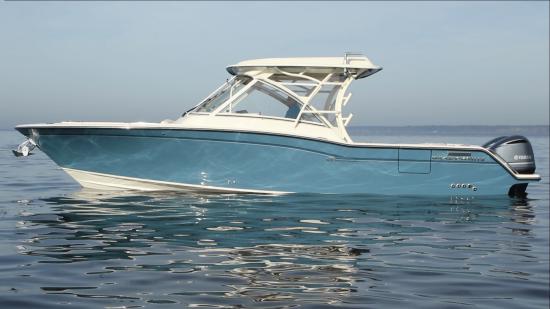
Overview
Grady-White has been building dual consoles for several decades and in fact was among the original pioneers in the design. It recognized early on that the layout would be, and has become, extremely popular and appealing with families looking to do more than just fish in the boat. The dual console design provides the day boat, fishing boat, cruising boat, and viable watersports platform that its customers and families were looking for, all with the space to take more people on the water at one time.
Regardless of the size or model, the boats always start with Grady-White’s tried and tested SeaV2™ hull, providing the foundation and handling that is unique to the brand. Then it’s a matter of mating the fishing features with the family amenities, to create the popular final product. The result is a full line of dual consoles, 10-strong now. They run from the 19'2" (5.84 m) Freedom 192 on up to the 36'7" (11.15 m) Freedom 375 and everywhere in between that a buyer’s budget will allow.
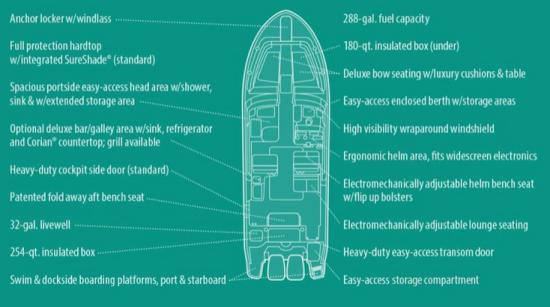
Features Inspection
Cockpit
We enter the cockpit through a starboard transom door from the swim platform, through the port side door, or just by stepping on the caprail and dropping in, so to speak. The cockpit presents slightly more than 32 sq. ft. (2.97 sq. m) of open space, ready to be converted into whatever we choose.
Fishing
Fishing features start with the padded bolsters that start at 20” (51 cm) and top out at 25” (64 cm). Four caprail mounted rod holders surround the cockpit. At the transom, there’s a 32-gallon (121 L) livewell with the usual features of blue interior, rounded edges, etc. The lid serves double-duty as a cutting board. In the center of the transom is a 254-quart (240 L) fishbox, saving us the trouble of opening a deck hatch to store our catch. When it gets limited out, another 180-quart (170.34L) insulated box is under the bow seating. Under the livewell is a pull-out panel holding a pair of tackle sorters.
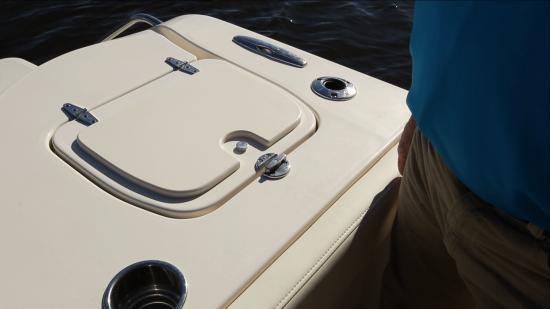
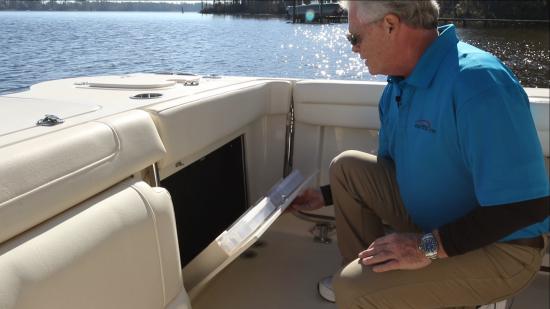
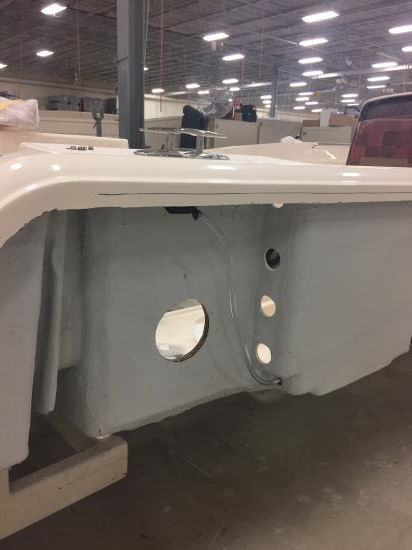
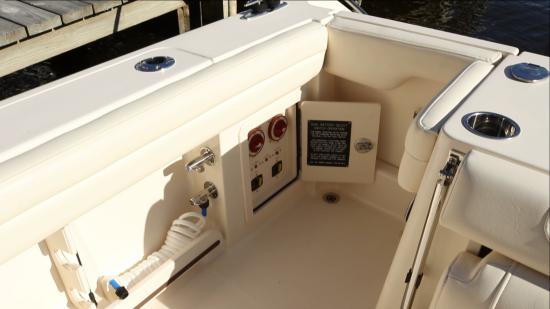
To the starboard side there are under gunwale rod racks, a fresh and raw water washdown, and toe rails for added support when working a fish. Interestingly, these toe rails are slightly lower than those that we usually see. While we don’t typically measure these things, we’ve always noticed that there’s typically a lot of room to raise the feet before the rail starts to add its support. Here, the feet are snug to the rail even when flat on the deck.
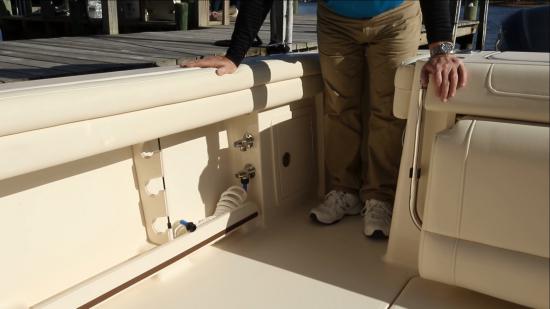
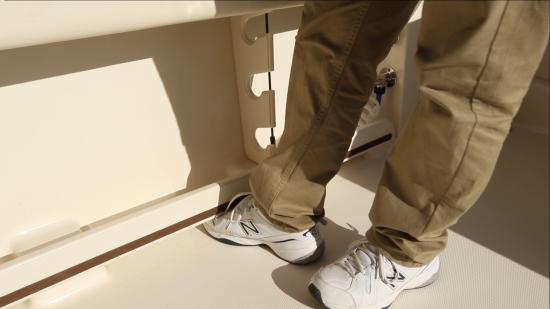
And then there are the four rod holders to the aft side of the hardtop supports, the aft-mounted spreader lights, and the reinforced sections of the hardtop for supporting outriggers. And of course it bears mentioning that virtually everything that can collect water on this boat is also designed to drain that water so that the whole boat transitions from hard fishing to family and entertaining, with little more than a few minutes with a hose.

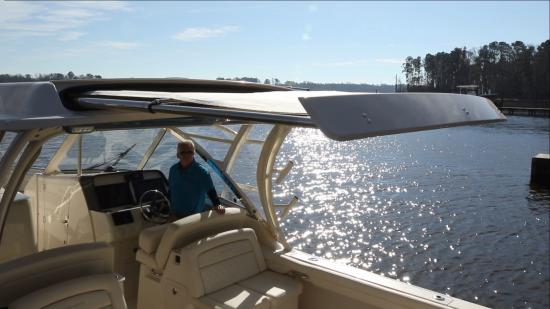
Entertaining
Of course, the Freedom 325 allows the “freedom” to engage the family in watersports. With this newest model of the Freedom lineup, the swim platforms are now integrated into the hull mold. This gives the 325 a longer LOA, but Grady-White also adds the centerline length to the boats’ specs so they’re clearly not going for fake measurements. It also allows for an apples-to-apples comparison with the other models.
There’s a four-step reboarding ladder to the starboard swim platform. A retractable ski tow pylon is recessed into the aft side of the transom. And a wet storage area for those used towels is just aft of the transom gate.
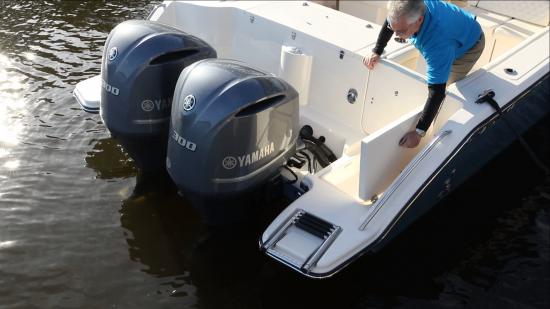

As a dive platform, the standard hull side dive door to the port side of the cockpit will be a welcome addition. And we noticed that both this dive door and the aft cockpit door are fitted with latch handles that can easily be opened with one hand. Others require both hands to open, one to release a latch, the other to manipulate the handle. We suspect this will not go unnoticed by those other builders.
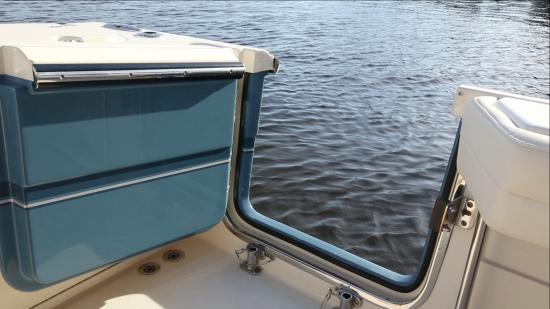
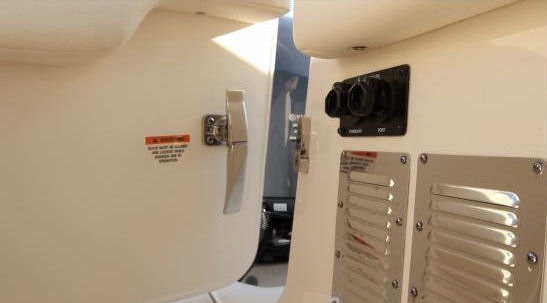
Seating is Another Aspect Where the Freedom 325 Shines. It has the pull-out transom bench seat in the usual position, but Grady-White seems to have a good take on the ease of use. Just pull up the bottom and it turns into a seat. No mussing or fussing. Even better is the way it stows. Grab the two sides at the rear and lift, and it can be dropped back down into the flush stowed position. At first attempt, this feels like the side frames are going to trap one’s hand and crush their fingers, but it’s not even close. It just takes one try to see that, and then it’s sort of a relaxing feeling knowing how safe from harm it actually is.
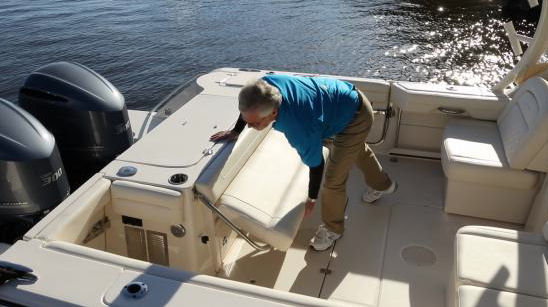
A lot of thought went into the comfort level of the seat, too. The seat base is angled slightly down in the back so it holds its occupants a little better. The seatback is also angled so it’s more relaxing to sit in.
Next are the Two Aft-Facing Seats Just Ahead. They’re double-wide so now we have room for six in opposing seats in the cockpit alone. Plus, both of these seats electrically, and individually, convert to aft-facing chaise lounges. This is a great idea and actually quite unique but we’d like to see a repositioning of the actuator switches. One is next to the starboard seat and the other is ahead of the observer’s seat, which puts it out of view of the seat when activating. Having them together at the starboard seat position would be ideal.
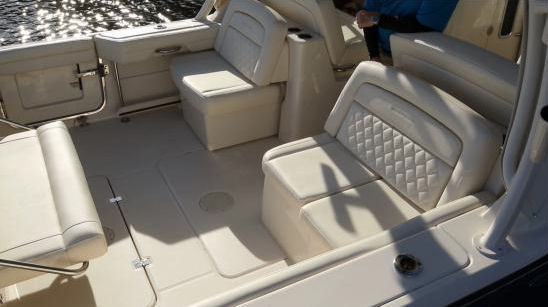
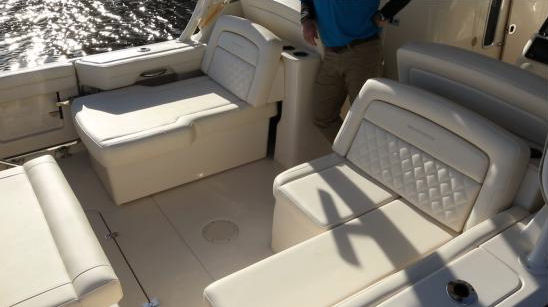
They also convert to chaise lounges at the touch of a button… actually, two buttons, one for each seat.
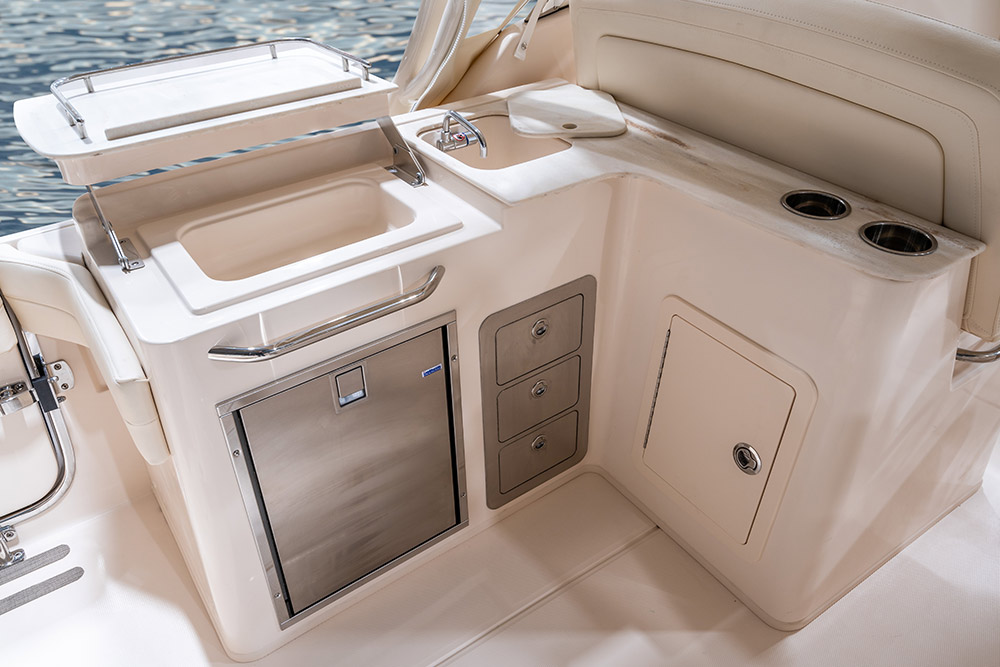
The seat to the port side can be swapped out for an optional refreshment center that includes a sink, electric grill, refrigerator, counter prep area, and storage (artist rendering only).
Service Points
If we lift up the transom bench seat and open the deck hatch, we gain access to the large “mechanical room.” It contains all of the mechanical equipment in one place for easy servicing of the boat’s systems. It includes the 5 kW diesel generator, bilge pumps, macerator pumps, thru-hull fittings, seacocks, and handle extensions leading to those seacocks so we don’t have to open the hatch to shut them off. Just pop off the round deck plate.
The generator is powered by a 12 gallon (45 L) tank and it averages just under .2 gallon/hour (3.79 L/hr) when running. Now, before doing the math and coming up with 60-hours run time, consider that the only time we’ll need the generator is when we’re using the optional electric grill, the refrigerator and/or the cabin air conditioner. So this supply could conceivably last for days, certainly throughout a long weekend. We can also power all of this from the 30-Amp shore power connection, bringing the endurance of that diesel tank even further.
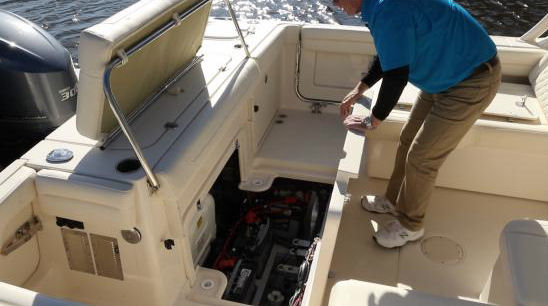
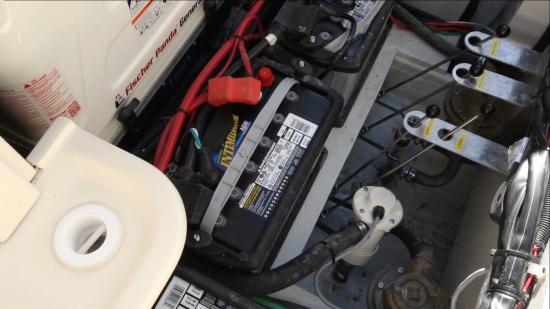
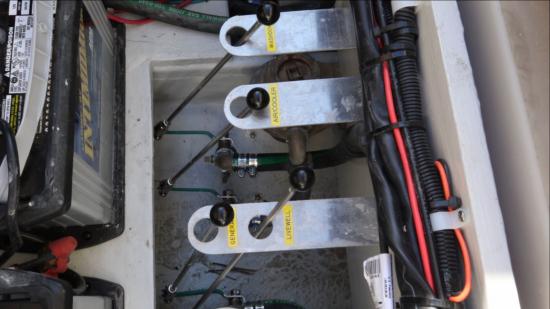
Observers Position
The observer gets a comfortable doublewide seat. To the port bulkhead there are beverage holders, a grab handle, an air conditioner vent, a padded storage shelf, and an accessory plug and USB connectivity. Further down is a speaker. Just below the vent is the switch for the port side chaise lounge adjustment. Ahead, and to the top of the console, is another recessed and padded area for putting stuff, plus another grab handle.
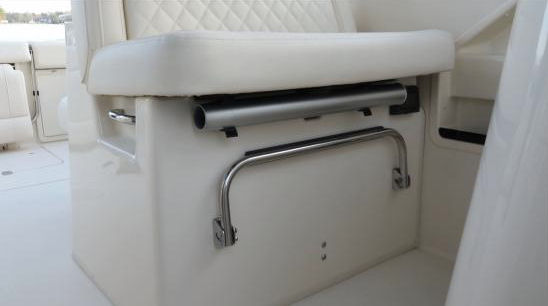
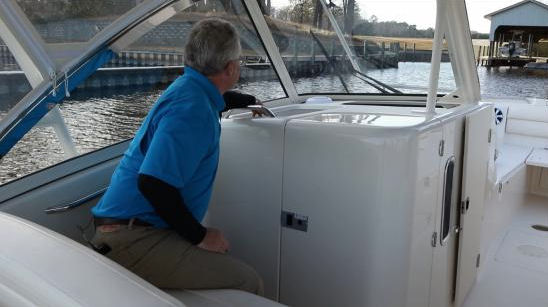
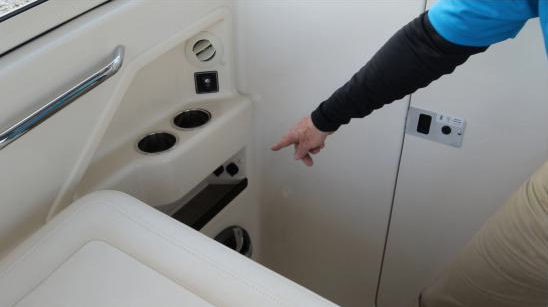
Helm
The helm console is well laid out and nicely appointed. Our test boat had a pair of 17” (43.2 cm) displays but those were put in after-market. Grady-White is not in the electronics business, and as such, it is not married to any one brand. That is a decision best left to the owner.
The helm is, however, well represented by Grady-White’s longtime business partner, Yamaha Outboards, and the Command Link display is nicely positioned to the left of the wheel. To the right of the console are the trim tab controls, lighted rocker switches and Helm Master joystick. Just behind is the binnacle for the engine controls. The steering wheel is stainless and includes a steering knob.
To the right of the helm seat is another storage area, similar to what we saw at the observer’s station. The helm seat is doublewide, much like the observer’s seat, only this time it is fitted with individual flip-up bolsters.
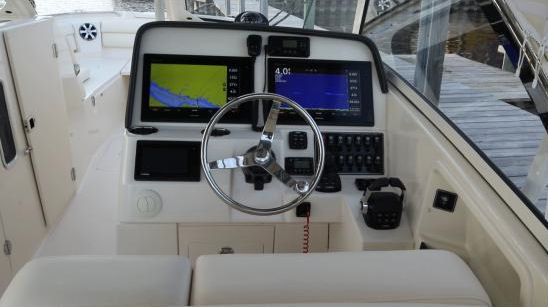
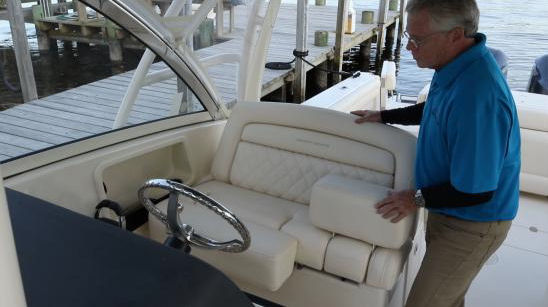
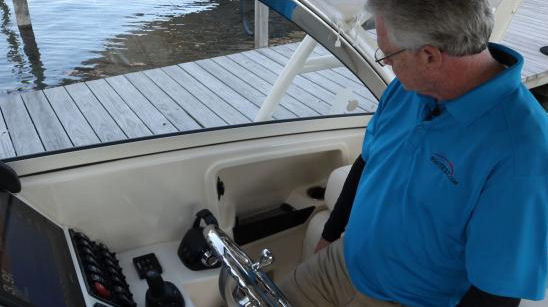
Consoles
One of the many changes that this version brings to the design table is a distinct reversal in the layout of the consoles. The head on previous models was to starboard and storage was to port. Now that is changed.
Grady-White correctly envisioned that the customer would be using the head far more than a sleeping area and as such, moved that space to the port compartment. In doing so, it was able to add many more amenities to the head that would not have otherwise been possible. And these improvements are evident right from the first glance.
In addition to the obvious increase in space, overhead clearance is 5’1” (1.55 m). The head is well appointed with a VacuFlush toilet, an opening portlight, a solid surface counter with a single basin stainless steel sink, a cedar locker, and additional storage is accessed from the forward bulkhead that opens to the port bow seat storage locker. In this manner, that compartment can hold rods that will partially enter the head compartment. That is a small trade-off for a boat of this size, and a fair one. Certainly when we take the boat out, those rods can be relocated to the rod holders surrounding the cockpit, whether they’re intended to be used or not.
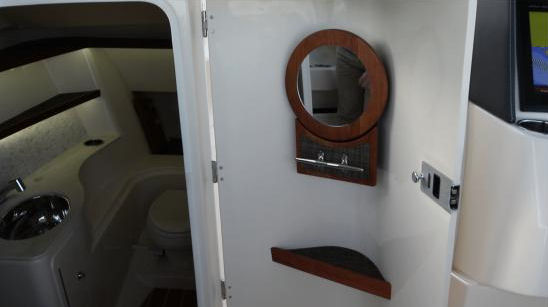
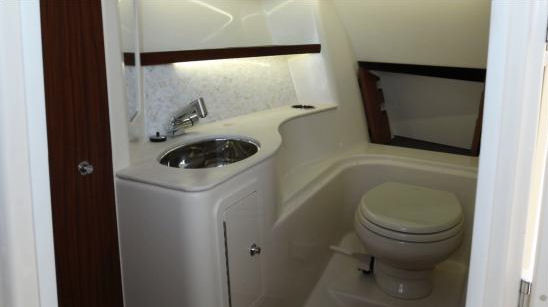
The starboard console is now designated for storage, sitting and, should the need permit, sleeping. That bed will measure 6’1” (1.85 m) in length. Overhead clearance is 5’2” (1.58 m).
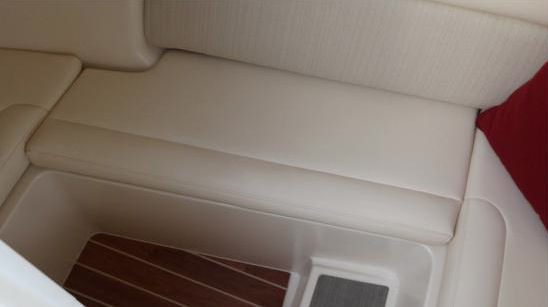
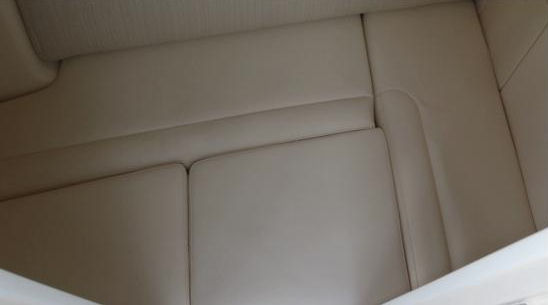
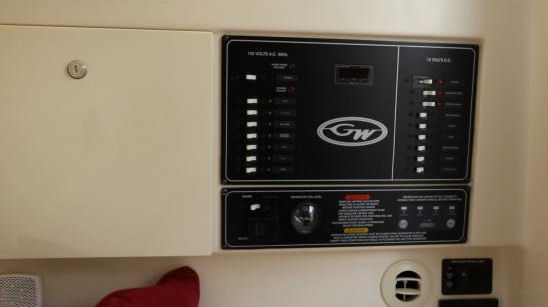
Walkthrough
As is usually the case with bowriders, the walkthrough windshield closes off and a lower air dam swings into position to block the wind on those chilly mornings. On the Freedom 325, the windshield is huge, so at the top of the walkthrough there’s a separate section that swings open from top hinges to allow for a more manageable opening section while maintaining the headroom that the hardtop provides. Both the main walkthrough section and the separate overhead piece, have dual latches that are interconnected. Turning one turns both. With everything opened up, we’re still left with a walkthrough to the bow, 24" (61 cm) wide.
Bow
The bow area consists of two forward facing lounges 5’10" (1.78 m) in length, 33” (84 cm) wide with 2’ (.60 m) between the two seats. This translates to seats that are seat-and-a-half width with plenty of room for occupants to face each other without knocking knees together. The lounges include seatbacks that are comfortably reclined. Flip-down armrests are to the inboard sides and we appreciate this design over the flip-up versions, as these don’t require any unlocking or unlatching to deploy or stow.
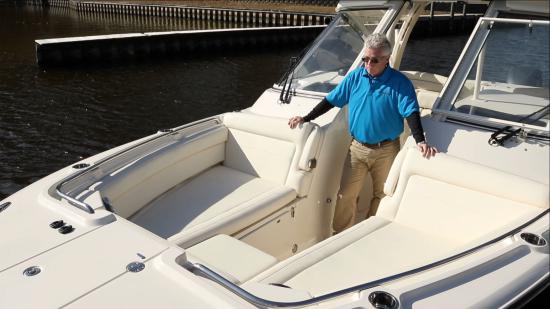
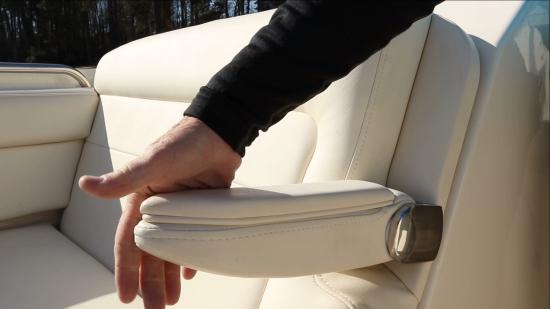
A padded bolster surrounds the bow and serves as a comfortable armrest. A recessed grab rail runs around from the seatback up to, but not including, the mid-section of the bow. Beverage holders are conveniently located. Speakers are forward-mounted and aft-facing.
There’s Storage Under the Two Seats and it’s Pretty Impressive. The port side has open storage, but as we mentioned in the head compartment section, there are also two flip-open panels that convert the storage into rod storage. The handles of the rods will extend into the head compartment. To the starboard side is an insulated cooler/fishbox. It measures in at 180-quart (170 L) and is self-draining. Fully forward is a panel that lifts on hinges to allow access to the rode locker underneath.
We can add a pedestal table to increase the utility of the bow area and turn it into a snack/cocktail area. We can remove the pedestal and lower the table, and then add cushions to form a sun pad. It’s important to note that when doing this, a shorter pedestal is not required. The table sits on small ledges to both sides that act as supports. And of course, with the cushions removed, a large casting deck is created.
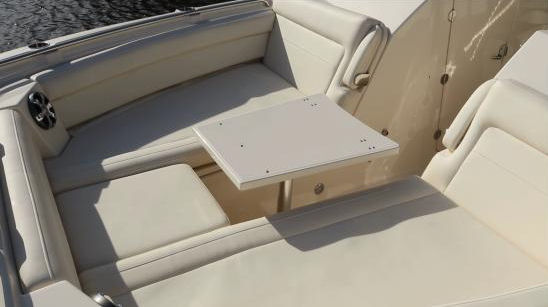
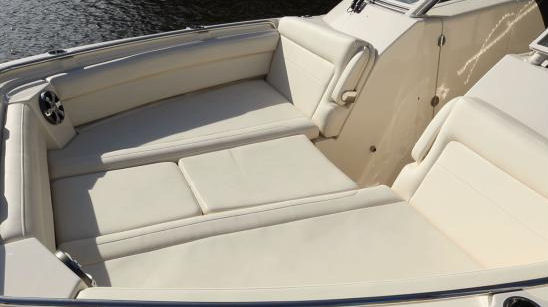
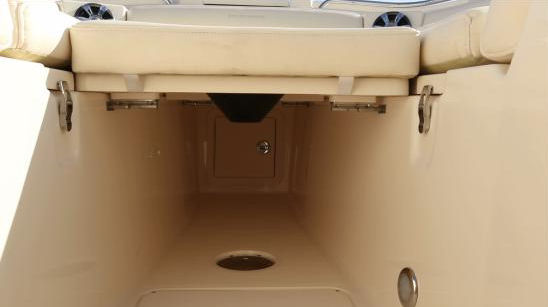
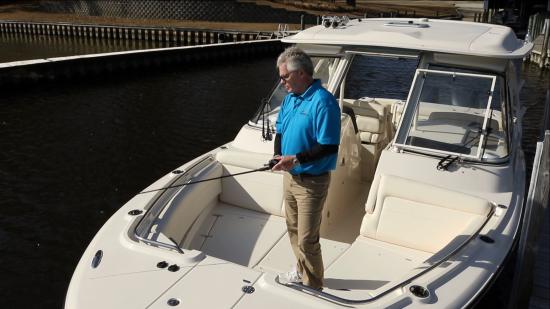
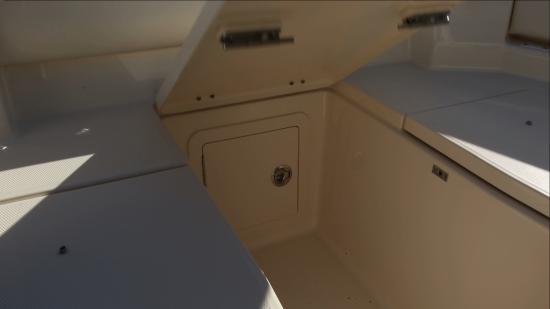
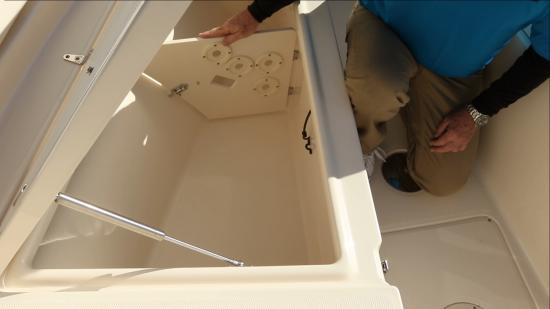
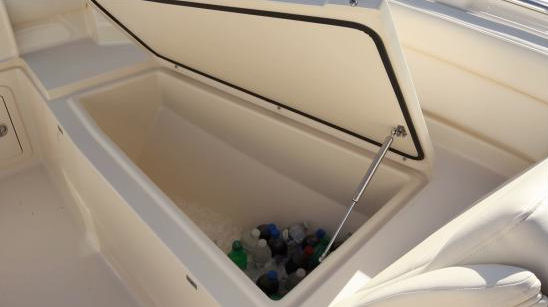
Foredeck
Fully forward, a combination of pull-up cleats and a retractable navigation light serve to make a flat surface that won't snag fishing lines. A large hatch is in the center of the deck that opens with a turn-and-lock latch. As usual, we would like to see this converted to a lift-and-lock latch that locks automatically, rather than having to be turned in the correct position.
The hatch is held open by a stainless steel support strut. Inside, is an electric Pro Fish windlass leading out to a through-the-stem anchor roller. There is a safety wire attached to the port bulkhead. A cleat is to starboard for securing the rode and taking the strain off of the windlass. Controls are to the right of the hatch and additional controls are at the helm.
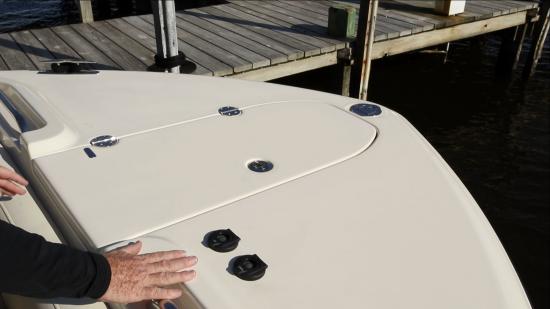
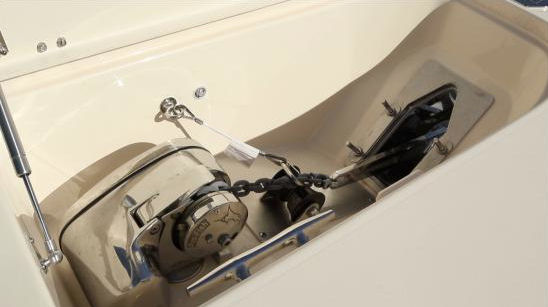
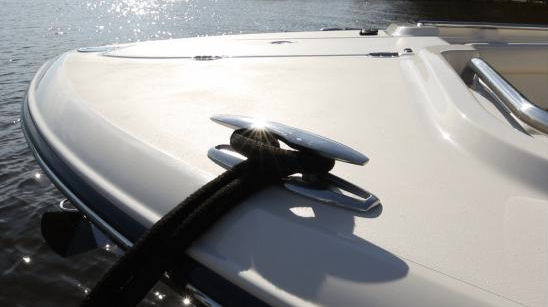
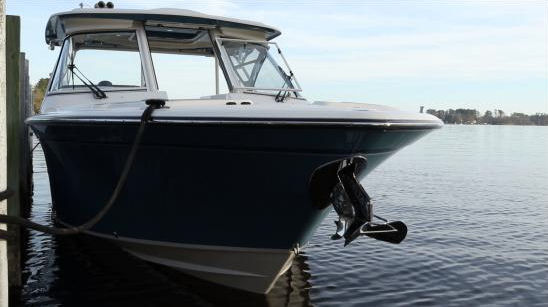
Test
The Grady-White Freedom 325 has a LOA of 33’1” (10.08 m), a beam of 10’9” (3.28 m), and a draft of 24" (61 cm). With an empty weight of 9,300 lbs. (4,218 kg), half fuel, two people and test power, we had an estimated test weight of 11,708 lbs. (5,311 kg).
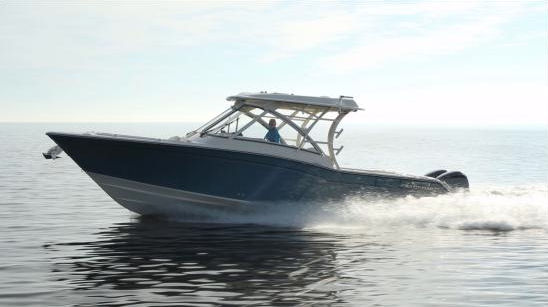
With a pair of 300-hp Yamaha 4-strokes turning 15 ½ x 17 Saltwater Series II props, we reached our top speed of 48.1 mph at 6000 rpm. We measured her best economic cruise at 3500 rpm and 27.1 mph. At that speed, the 17.2 gph fuel burn translated into 1.6 mpg and a range of 409 miles, all while still holding back a 10% reserve of the boat’s 288-gallon (1,090 L) total fuel capacity.
Thanks to her SeaV2 hull, we reached planing speed in 3.5 seconds, accelerated to 20 mph in 5.3 seconds, and 30 came and went in 8.2 seconds. About seven clicks of the engine trim gets her into her running attitude. We did notice that if we accelerated slowly, she needs to be pushed to get her up on plane, but once up there, she’ll stay planing down to a much lower speed setting. Such is one of the many benefits of the hull design. More efficiency at lower speeds.
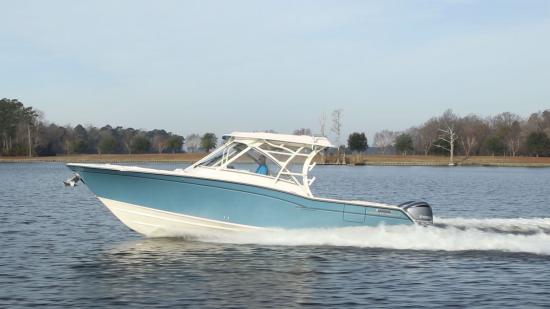
Handling
The Freedom 325 has a sporty feel to her handling. With flat calm conditions, we were left with crossing wakes to see how the SeaV2 hull handles chop and it was impressive. From the side, she hits the wake with a solid blow but her heavy build transfers that to the whole boat, so there is no sensation of pounding whatsoever. Spray is kept low and wide. Her buoyancy lifts her across the waves and as she re-enters, it’s a graceful press into the water as she re-stabilizes quickly for a clean and smooth transition. With the wakes head on it’s little more than a clean slice through.
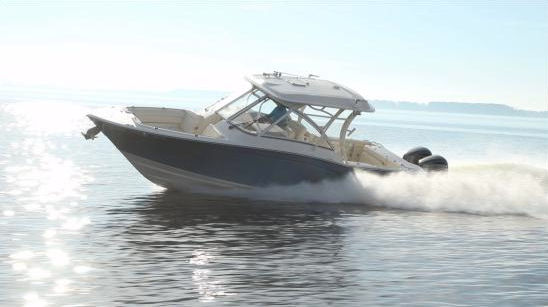
Our turn tests were even better. The Freedom 325 turns as if on rails with a good roll that initiates the turn that negates the centrifugal force and keeps everyone well placed in the seats. We found no chine walk whatsoever, but more importantly, she rights quickly. These two combinations should prove quite beneficial when running in quartering seats. We would expect a ride with good tracking and stability. With her high freeboard of 33” (84 cm) at the stern and 47” (119 cm) at the bow, she’s also ideally suited for long offshore runs. She’ll also dig her shoulder in with a hard turn held on, so go ahead and add throttle to keep the speed up, otherwise shallow up the turn. With 6 ½ turns from lock-to-lock, she remains steady and stable, regardless of how heavy handed a test captain tries to get with her.
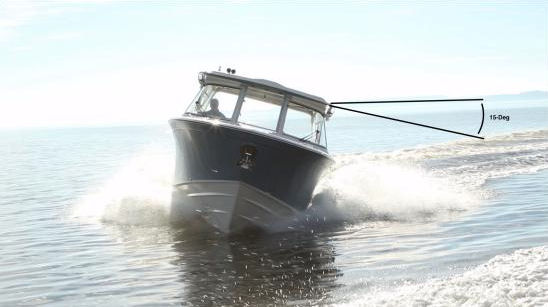
Docking
When it came time to return to the dock, the Yamaha Helm Master™ joystick took all of the workload out of the task and left us with an easily maneuvered boat that only took gentle pulses on the stick to provide precision handling around the dock.
Observations
The Freedom 325 was certainly an impressive boat and clearly serves well at filling a slot that will allow buyers to make the step from one boat to another, rather than require a giant leap. It’s a good idea for Grady-White, and its customers. Now with 10 boats to its dual console lineup, Grady-White has further solidified its standing in this coveted marketplace. The only problem is in deciding which one to settle on.

